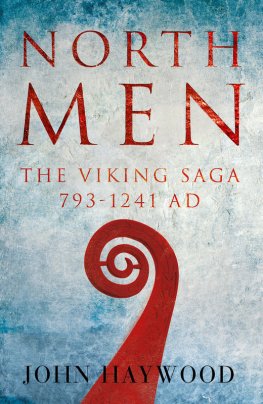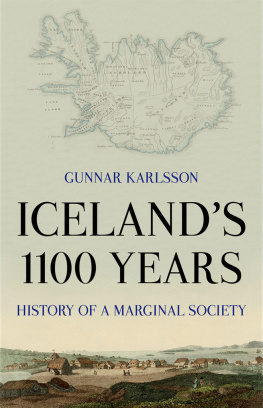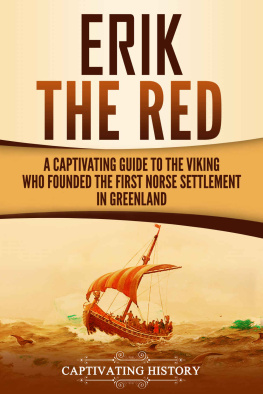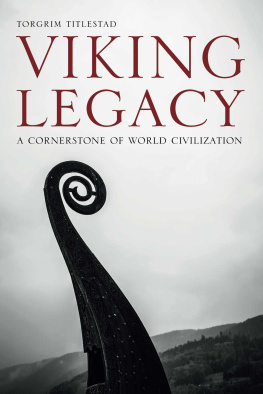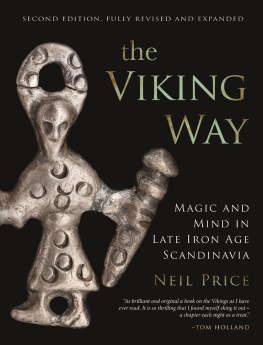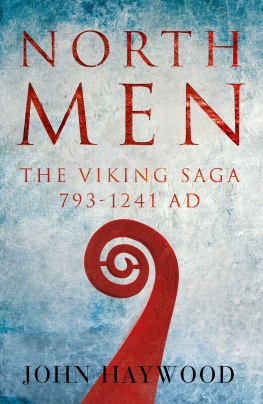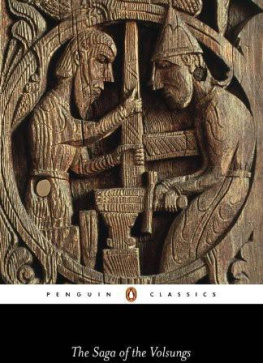Jesse L. Byock is Professor of Old Norse and Medieval Scandinavian at the University of California, Los Angeles, and a member of the UCLAs Cotsen Institute of Archaeology. He has published numerous articles and books on Iceland and the sagas, including Medieval Iceland: Society, Sagas and Power, Feud in the Icelandic Saga and translations of The Saga of King Hrolf Kraki and The Saga of the Volsungs, both published in Penguin Classics. Professor Byock received his Ph.D. from Harvard University after studying in Iceland, Sweden and France. A specialist in North Atlantic and Viking studies, his work has been supported by grants from the National Endowment for the Humanities, the Fulbright Foundation, the National Science Foundation and the John Simon Guggenheim Foundation.
JESSE L. BYOCK
Viking Age Iceland

PENGUIN BOOKS
PENGUIN BOOKS
Published by the Penguin Group
Penguin Books Ltd, 80 Strand, London WC2R 0RL , England
Penguin Putnam Inc., 375 Hudson Street, New York, New York 10014, USA
Penguin Books Australia Ltd, 250 Camberwell Road, Camberwell, Victoria 3124, Australia
Penguin Books Canada Ltd, 10 Alcorn Avenue, Toronto, Ontario, Canada M4V 3B2
Penguin Books India (P) Ltd, 11 Community Centre, Panchsheel Park, New Delhi 110 017, India
Penguin Books (NZ) Ltd, Cnr Rosedale and Airborne Roads, Albany, Auckland, New Zealand
Penguin Books (South Africa) (Pty) Ltd, 24 Sturdee Avenue, Rosebank 2196, South Africa
Penguin Books Ltd, Registered Offices: 80 Strand, London WC2R 0RL , England
First published 2001
Copyright Jesse L. Byock, 2001
All rights reserved
Except in the United States of America, this book is sold subject to the condition that it shall not, by way of trade or otherwise, be lent, re-sold, hired out, or otherwise circulated without the publishers prior consent in any form of binding or cover other than that in which it is published and without a similar condition including this condition being imposed on the subsequent purchaser
978-0-14-193765-6
To Gayle for all kinds of good reasons
Latin books name that land Thule, but northmen call it Iceland. This can be said to be an appropriate name for the island, because there is ice both on land and sea. In the sea there is drift ice in such quantity that it fills the northern harbours, while permanent glaciers cap the countrys high mountains Sometimes, from beneath the mountain glaciers, great rivers of water stream out in floods Other mountains of that land erupt with terrible fire, spewing out a cruel rain of stones Bubbling pits of hot water and sulphur abound. There are no woods except for some small birch. Grain, but only barley, grows in a few places in the south The country is most widely settled along the coast, with the eastern and western parts being least populated.
The Saga of Bishop Gudmund
Contents
List of Illustrations
List of Maps
Acknowledgements
I am indebted to my many Icelandic friends, especially Professors Helgi Thorlksson and Gunnar Karlsson for their reading of chapters. I consider it my great good fortune to have had their counsel and the benefit of their deep understanding of Icelands development. I have adored maps since I was a child, when my father taught me the wonders of the atlas. An inordinate amount of time went into researching and designing the many maps and illustrations used in this book. Here I was aided by four especially skilful cartographers and artists: Robert Guillemette, Jean-Pierre Biard, Gumundur l. Ingvarsson and Lori Gudmundson. Working with people of such knowledge was for me a great experience. Thanks also to Andrew Dugmore for his generous permission to use his illustrations.
My thanks to Gumundur lafsson from Icelands National Museum for sharing with me the archaeological floor plans to Greluttt. Gumundur has been a valuable colleague in the Mosfell Archaeological Project. I also want to extend my warmest thanks to Hrur gstsson, who gave me the use of his architectural drawings. With wit and humour, Hrur has over the years shared with me his wide knowledge of medieval Icelandic and Norwegian buildings. My thanks also to the architects Grtar Marksson, Stefn rn Stefnsson and Hjrleifur Stefnsson, who so graciously and enthusiastically shared their expertise in turf construction. Kristjn Jhann Jnsson provided insightful comments on the manuscript. I want to thank my father, Lester Byock and my uncle, Harold Williams. Both are gone now, but I know they would smile at the turf section. It would not have been written but for them. Growing up with these wonderful men, and with my mother Cele Williams Byock and her great interest in design, meant that before I could read or write I knew something of construction and architecture. They instilled a lifetime lesson in craftsmanship.
Scholars often groan at the amount of work, angst and pain put into writing a book. Despite all that, I thoroughly enjoyed writing this book. In part this is because the time of research and writing corresponded to a period of grants which allowed me to spend almost three wonderful years in Iceland. Thus I would like to thank these generous benefactors: the Fulbright Foundation; the University of California Presidents Fellowship; the National Endowment for the Humanities; the John Simon Guggenheim Memorial Fund; the Icelandic Ministry of Culture and Education; the UCLA Academic Senate, and Provost Brian Copenhaver and Dean Pauline Yu of the UCLA College of Letters and Science.
Further, I offer my thanks to the Willard Fiske Center at the USIS office in Reykjavk, and especially to the head of that office, Walter Douglas, and his wife, Nancy. At the darkest moments of winter, the Douglases rediscovered the art of mixing a Manhattan, and the light almost returned. I also owe thanks to the American Ambassador, Day Mount, who together with Walter Douglas arranged for me to use an office, which was of much help. So, too, my deep gratitude to my daughter Ashley and my wife Gayle, who read many drafts and, as always, were filled with insightful comments. Grace Stimson, as remarkable as ever, had much to say about making English flow. Clare M. Gillis, an excellent student and dedicated assistant, worked for me in Reykjavk. Clare held a Fulbright scholarship to Iceland and acquired a great knowledge of Iceland and the sagas. Finally I want to thank my friends at Slon slandus and the old Kaffi List. There was no end to the amusement and inspiration found at these places.
Preface
I wanted to write a book that would explore the workings of Icelands medieval society and would serve as a companion to reading the sagas. The result, I hope, deepens our understanding of the social forces and environmental factors which shaped the lives of medieval Icelanders in the period from the tenth to the end of the thirteenth century. These centuries, which saw Icelands discovery and its subsequent development, coincide to a great extent with Scandinavias Viking Age, and Icelands experience is a rich part of that age.
A good portion of my life has been spent in Iceland. As a young man, I worked herding sheep on farms on the northern fjords, especially in the county of Hnavatnssla. The experience has stayed with me, leaving an intimate awareness of the skills of survival so necessary in that far northern environment. In this book I have tried to bring this awareness to the fore. It is not only the cold and the hardship of keeping animals alive through the winter that I remember, but also the beauty of the landscape, the bright warmth of the summers, the wild horses in the highlands, and the friendship of the farmers. In particular I want to thank Karl, Margrt and Tryggvi from the farm of Straborg, and Vilhjlmur and Margrt at Gauksmri.



